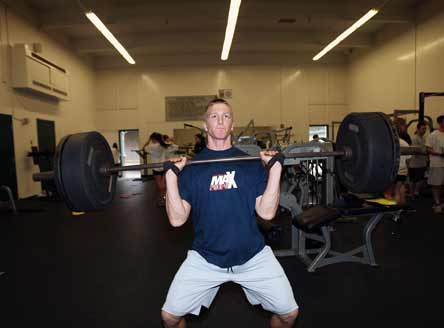Strength training isn't what it used to be: Three rules to conditioning high school athletes.

The power clean is a traditional football lift that is considered one of the three "must do" exercises. The potential for injury is high, though, and there are much safer lifts that are just as beneficial.
Photo by Todd Shurtleff
The era of a team assistant doubling as a strength coach is gone.
Remember that? The assistant was the most experienced staff member in the weight room and usually was a football player in his day. Strength training was just being uniformly accepted as something that athletes should do, so why not include it after practice a few days a week?
Fast-forward to the present day and strength training for high school athletes has exploded around the world.
There are combines and weekend showcases to profile students' athletic abilities for recruiting services and college coaches. Depending on the sport, how high the athlete's vertical jump is and how much weight they can lift on the bench press is just as important as their game performance.
So it's time that we erase what our dominant theories about strength and conditioning programs are and take a quantum leap into what they need to be. I introduce you to the new rules of scholastic strength and conditioning.
Rule No. 1: Traditional "must do" exercises no longer cut itAnyone who has ever lifted weights under a team coach is used to being drilled into performing any combination of the squat, bench press or power clean every workout. Those are the old exercises that every athlete must do or else they won't get bigger, stronger or faster, right? While there's nothing wrong with these movements per se, when you weigh the risk-benefit ratio of each you'll find that you can enhance performance faster with less risk with other exercises.
Even at the best Division I college programs, a team may consist of anywhere from 15 to 40 student-athletes who have one hour to train under the guidance of only one to four strength coaches. Most of the time the strength coach doesn't even oversee the workout, their graduate assistants or student interns do.
Now think of your high school that probably only has one coach for that same number of athletes.
The squat, bench press and power clean have to be performed under extreme guidance because once the athlete loses focus, and high school athletes often do, the risk of those movements increases tenfold. Instead use movements that are easily coached, provide the same benefits and do not have to be as strictly monitored like the single leg split squat, dumbbell chest press, medicine ball throw and single-leg dumbbell dead-lift.
Rule No. 2: Reward progression and performanceTo get optimal results, athletes just can't lift weights. There has to be a progression system in place for the athlete to continually make gains in the program. A reward for increased weight lifted is as simple as writing their name and total lifted on a wall in the gym. This fosters team-building and competition at the same time.
Rule No. 3: Include dynamic mobility in the programAthletes warm up for games, so why not the workout? Dynamic mobility drills provide a way to identify and prevent potential injuries while helping to enhance any stretching that may be done. Think of it as stretching with subtle hip or shoulder motion. While there are hundreds of options, including a few that will go a long way into helping the athlete get rid of nagging pain and increasing their readiness.
I don't want to completely overhaul a program. Remember, these athletes are just getting exposed to weight training, let's give them the smallest possible exposure so that they can be developed throughout their scholastic career.
Jimmy Smith, MS, CSCS, is a performance therapist and nutritional consultant based in Stamford, Conn. He offers various online consulting services on his website.